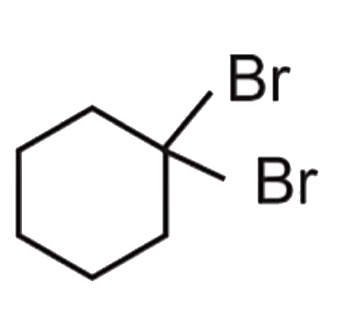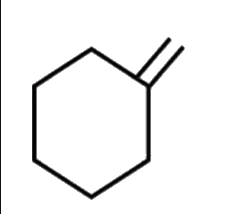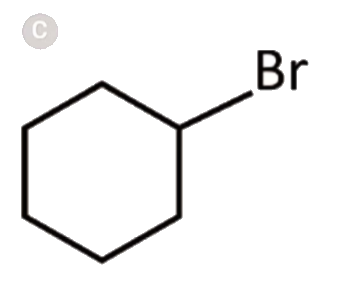Which reaction produce 1-methylcyclohexene

(i)aq.KOH−−−−−−−−−−−−−−−−−−−−−−−→(ii)CH3MgBr,ether,(iii)H+,H2O

(i)HBr−−−−−−−−−−−−−−→(ii)alcoholic KOH.Δ

(i)Mg,ether−−−−−−−−−−−−−−−−→(ii)CH2O,(iii)H+,H2O

(i)HI−−−−−−−−→(ii)aq.NaOH
The correct Answer is:B
To determine which reaction produces 1-methylcyclohexene, we need to analyze the provided options step by step.
1. Understanding the Product:
- The target product is 1-methylcyclohexene. This means we have a cyclohexene ring with a methyl group attached to the first carbon of the double bond.
2. Analyzing the First Option:
- The first option involves a dibromocyclohexane reacting with aqueous KOH followed by a Grignard reagent (CH3MgBr).
- The aqueous KOH will replace the bromine atoms with hydroxyl groups, leading to a diol.
- The diol will then undergo dehydration to form a ketone-like structure, which is not the desired product. Thus, the first option does not yield 1-methylcyclohexene.
3. Analyzing the Second Option:
- The second option starts with a cyclohexyl bromide reacting with HBr.
- This reaction will form a carbocation. The more stable carbocation will be formed at the tertiary position due to the presence of a methyl group.
- The bromide ion will then attack the carbocation, leading to the formation of a bromo compound.
- When treated with alcoholic KOH, the base will abstract a hydrogen atom, resulting in the formation of 1-methylcyclohexene. This option successfully yields the desired product.
4. Analyzing the Third Option:
- The third option involves a Grignard reagent reacting with a compound to form an alcohol.
- The product from this reaction will not lead to the formation of 1-methylcyclohexene but rather an alcohol, which is not the target product.
5. Analyzing the Fourth Option:
- The fourth option also involves a carbocation formation but leads to a different product when treated with aqueous NaOH.
- The product formed here is an alcohol, not 1-methylcyclohexene.
Conclusion:
After analyzing all options, we find that the second option is the correct reaction that produces 1-methylcyclohexene.
- The target product is 1-methylcyclohexene. This means we have a cyclohexene ring with a methyl group attached to the first carbon of the double bond.
- The first option involves a dibromocyclohexane reacting with aqueous KOH followed by a Grignard reagent (CH3MgBr).
- The aqueous KOH will replace the bromine atoms with hydroxyl groups, leading to a diol.
- The diol will then undergo dehydration to form a ketone-like structure, which is not the desired product. Thus, the first option does not yield 1-methylcyclohexene.
- The second option starts with a cyclohexyl bromide reacting with HBr.
- This reaction will form a carbocation. The more stable carbocation will be formed at the tertiary position due to the presence of a methyl group.
- The bromide ion will then attack the carbocation, leading to the formation of a bromo compound.
- When treated with alcoholic KOH, the base will abstract a hydrogen atom, resulting in the formation of 1-methylcyclohexene. This option successfully yields the desired product.
- The third option involves a Grignard reagent reacting with a compound to form an alcohol.
- The product from this reaction will not lead to the formation of 1-methylcyclohexene but rather an alcohol, which is not the target product.
- The fourth option also involves a carbocation formation but leads to a different product when treated with aqueous NaOH.
- The product formed here is an alcohol, not 1-methylcyclohexene.
After analyzing all options, we find that the second option is the correct reaction that produces 1-methylcyclohexene.
Similar Questions
Knowledge Check
The reaction
 produces : A
produces : A B
B C
C D
D
Which of the following is the best stereochemical representation when reaction between 1-methylcyclohexene and NBS react in aqueous dimethyl sulfoxide ?
A B
B C
C DNone of these
DNone of theseWhich is the most precise designation of stereochemistry for the products formed in the electrophilic addition of DBr to 1-methylcyclohexene ? (D=2H, an isotope of hydrogen)
A B
B C
C DBoth (a) and (b)
DBoth (a) and (b)
Using anhydrous AlCl3 as catalyst, which one of the following reactions produces ethylbenzene (PhEt) ?
View SolutionWhich of the following reaction produces hydrogen ?
View SolutionWhich of the following compounds is (S) - 4 - chloro - 1- methylcyclohexene ?
View SolutionWhich reagent will produce salicyldehyde on reaction with phenol?
View SolutionWhich of the following reaction does not produce ethyne ?
View Solution
